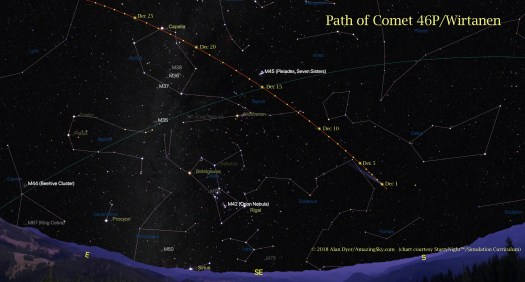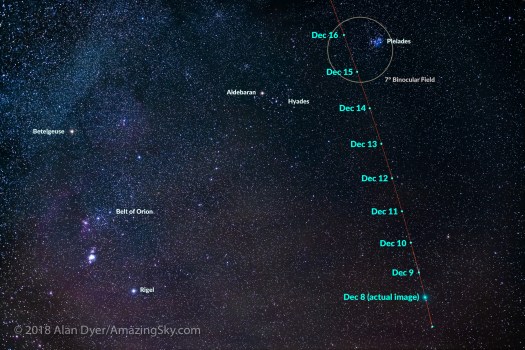
A well-known comet is making its closest approach to Earth in many years and promises a good show.
Comet Wirtanen is now climbing up the late autumn and winter sky for northern hemisphere viewers, and is already a fine binocular comet. By mid-December it might be bright enough to be visible to the naked eye, but only from a dark rural site.
Discovered in 1948 by Carl Wirtanen at the Lick Observatory, his namesake comet orbits the Sun every 5.4 years. So unlike other recent bright comets that have visited us for the first time, Comet Wirtanen (aka 46P) is well known. It is one of many “Jupiter-family” comets whose orbits have been shaped by the gravity of Jupiter and orbit the Sun about every 6 years.
So since it was discovered, Comet 46P (the 46th comet in the catalog of periodic comets) has been well observed. It isn’t better known because at most returns it never gets bright, and that’s because it never gets closer to the Sun than a little more than the distance from the Earth to the Sun. (Its perihelion distance is 1.06 AU, with 1 AU, or Astronomical Unit, being the average distance from Earth to the Sun.)
However, despite this, we’re expecting – indeed already enjoying – a good show at this return.
Due to the quirk of orbital clockwork, on this return the comet reaches its closest point to the Sun just before it is also closest to Earth.
That puts the comet “just” 11,680,000 kilometres from us at its closest approach to Earth on December 16, four days after perihelion, the point when the comet is closest to the Sun.

Comet Wirtanen will be relatively bright simply by virtue of its proximity.
But it is also an active comet, emitting a lot of gas and dust into a large “coma,” and that’s what we see, not the 1-kilometre-wide icy nucleus itself which is too small and shrouded by the coma. (As a footnote, Comet Wirtanen was to have been the comet that the European Rosetta probe was to visit, but launch delays forced ESA to switch cometary targets.)
Comet Wirtanen is glowing at magnitude 5 to 6, technically making it visible to the naked eye. However, because it is large and diffuse, in practice you need binoculars to see it – now.
But as it approaches Earth and the Sun, Wirtanen will brighten, perhaps to magnitude 3 (the brightest stars are magnitude 0 to 1), making it easier to see with the unaided eye from a dark site.
The one catch is that as it heads toward its brightest in mid-December the waxing Moon also begins to enter the sky and wash out the comet with moonlight.
The first two weeks of December will be prime time for Wirtanen

The first two weeks of December will be prime time for Wirtanen, with a particularly good opportunity coming on the evenings of December 15 and 16 when it shines below the Pleiades star cluster. The gibbous Moon will set about 1 to 2 a.m. with the comet still high enough for a dark sky view and photos.
Those will be great nights to shoot the comet and the cluster with a telephoto lens, provided the camera is on a tracker for untrailed exposures of 1 to 4 minutes. A 135mm to 300mm lens will frame the pair well.

After that, through late December, the bright Moon will interfere with the view. For example, a close approach of the comet near the star Capella on December 23 happens with the nearly Full Moon not far away.

I took the above close-up photo of Comet Wirtanen on December 6. It is a long-exposure telescopic view, but the comet is easy to see with binoculars. It appears visually and photographically as a diffuse fuzzball, with the camera recording a vivid cyan colour from glowing cyanogen and diatomic carbon molecules. You won’t see that colour with your eyes, even in a telescope.

Even at the comet’s best in mid-December any tail might be hard to see and even photograph (it appears faintly above) as it will be both faint and pointed directly away from us because, as comet tails do, it will also be pointed away from the Sun.
Look for a large glow which will be grey to the eye but green to the camera.
While you can just take pictures for yourself, astronomers are asking amateur astrophotographers to participate in a worldwide observing campaign to monitor Comet Wirtanen. More details are available here at wirtanen.astro.umd.edu and at http://aop.astro.umd.edu/
Clear skies and happy comet hunting!
— Alan, November 30, 2018 (Revised December 6) / © 2018 Alan Dyer / AmazingSky.com


Very interesting… thanks Alan!